Maya Lime Mortars—Relationship between Archaeomagnetic Dating, Manufacturing Technique, and Architectural Function—The Dzibanché Case
Abstract
:1. Introduction
- To what extent were the characteristics and components of these construction materials intentionally modified during the period of occupation and development of the site?
- Were the components and characteristics chosen according to the functions of the buildings or construction elements?
2. The Archaeological Site
3. Materials and Methods
3.1. Sampling Design
3.2. Radiocarbon Dating
3.3. Archaeomagnetic Dating
3.4. Petrography
3.5. SEM/EDS
3.6. XRD
3.7. Gas Chromatography and Mass Spectrometry
4. Results
4.1. Lime Matrix, Inclusions, and Their Proportions
- Gray inclusions formed by micrite, a little darker than the matrix; sometimes these inclusions can have an orange hue due to the presence of iron compounds. These are formed principally by peloidal micrite. They could be sascab or caliche fragments.
- Micritic inclusions with secondary porosity of considerable dimensions and irregular forms saturated with acicular calcite crystals (lublinite). They could be sascab or caliche fragments.
- Micritic stratified inclusions; the strata could be parallel or have irregular forms. Without doubt, these inclusions are from caliche.
- Brownish or sienna inclusions with a particular appearance under cross-polarized light: pattern of “nocturne sky” with a dark background with little shiny spots. The composition is of cryptocrystalline calcite. They could be lime lumps.
- Very homogeneous inclusions, with a similar color to the micritic cement but with internal fractures. They could come from partially calcined rocks, or lumps of quicklime that were not hydrated and not well mixed.
- Micritic inclusions with cryptocrystalline textures but with heterogeneous color: they have gray zones intercalated with black ones. They could be lime lumps contaminated with charcoal and soot or fragments of partially calcined rock embedded with charcoal and soot.
4.2. Organic Inclusions and Compounds Found in the Lime Plasters
4.3. Archaeomagnetic Dating
5. Discussion
6. Conclusions
Acknowledgments
Author Contributions
Conflicts of Interest
References
- Littman, E.R. Ancient Mesoamerican mortars, plasters and stuccos. Comalcalco part I. Am. Antiq. 1957, 23, 135–139. [Google Scholar] [CrossRef]
- Littman, E.R. Ancient Mesoamerican mortars, plasters and stuccos: The composition and origin of sascab. Am. Antiq. 1958, 24, 172–176. [Google Scholar] [CrossRef]
- Littman, E.R. Ancient Mesoamerican mortars, plasters and stuccos. Comalcalco part II. Am. Antiq. 1958, 23, 292–296. [Google Scholar] [CrossRef]
- Littman, E.R. Ancient Mesoamerican mortars, plasters and stuccos. Palenque, Chiapas. Am. Antiq. 1959, 25, 264–266. [Google Scholar] [CrossRef]
- Littman, E.R. Ancient Mesoamerican mortars, plasters and stuccos. The Puuc area. Am. Antiq. 1960, 25, 407–412. [Google Scholar] [CrossRef]
- Littman, E.R. Ancient Mesoamerican Mortars, Plasters, and Stuccos: Floor Constructions at Uaxactún. Am. Antiq. 1962, 28, 100–103. [Google Scholar] [CrossRef]
- Brown, G. Mortars for Tropical Archaeological Sites. Am. Preserv. Technol. Bull. 1987, XIX, 43–50. [Google Scholar]
- Brown, G. Testing of Concretes, Mortars, Plasters, and Stuccoes. Archaeomaterials 1999, 4, 185–191. [Google Scholar]
- Brown, G. Analyses and History of Cements; Gordon Brown: Ottawa, ON, Canada, 1996. [Google Scholar]
- Magaloni, D. Materiales y Técnicas de la Pintura Mural Maya. Master’s Thesis, UNAM-FFyL, Mexico City, Mexico, 1996. [Google Scholar]
- Magaloni, D. El Arte en el Hacer: Técnica pictórica y Color en las Pinturas Murales de Bonampak. In La Pintura Mural Prehispánica en México Bonampak; De la Fuente, B., Ed.; UNAM-IIE: Mexico City, Mexico, 1998; pp. 49–80. (In Spanish) [Google Scholar]
- Magaloni, D. Materiales y técnicas de la pintura mural maya. In La Pintura Mural Prehispánica en México Área Maya; De la Fuente, B., Ed.; UNAM-IIE: Mexico City, Mexico, 2001; pp. 155–198. (In Spanish) [Google Scholar]
- Guasch, N. Caracterització Dels Materials Constitutius de les Bases de Preparació de les Pintures Murals a les Terres Baixes Maies del Nord (península de Yucatán, Mèxic). Master’s Thesis, Universidad Politécnica de Valencia, Valencia, Spain, 2009. [Google Scholar]
- Villaseñor, I. Lowland Maya Lime Plaster Technology: A Diachronic Approach. Ph.D. Thesis, UCL (University College London), London, UK, 2009. [Google Scholar]
- Villaseñor, I. Building materials of the ancient Maya. In A study of Archaeological Plasters; Lambert Academic Publishing: Saarbrucken, UK, 2010. [Google Scholar]
- Vázquez de Agredos Pacual, M.L. La Pintura Mural Maya Materiales y Técnicas Artísticas; Centro Peninsular en Humanidades y Ciencias Sociales-UNAM: Mérida, Mexico, 2010. (In Spanish) [Google Scholar]
- Hansen, E.F.; Hansen, R.D.; Derrick, M.R. Los análisis de los estucos y pinturas arquitectónicas de Nakbé: Resultados preliminares de los estudios de los métodos y materiales de producción. In Proceedings of the Memorias del VIII Simposio de Investigaciones Arqueológicas en Guatemala 1994, Museo Nacional de Antropología y Etnología, City of Guatemala, Guatemala, 1995; pp. 456–470. (In Spanish)
- Hansen, E.F.; Rodríguez-Navarro, C.; Hansen, R. Incipient Maya burnt lime technology: Characterization and chronological variations in Preclassic plaster, stucco and mortar at Nakbé, Guatemala. In Materials Issues in Art and Archaeology; Vandivier, B., Druzik, J.R., Merkel, J.F., Stewart, Y.J., Eds.; Materials Research Society: Pittsburgh, PA, USA, 1997; pp. 207–216. [Google Scholar]
- Hansen, E.; Rodríguez-Navarro, C. Los comienzos de la tecnología de la cal en el mundo Maya: Innovación y continuidad desde el Preclásico Medio hasta el Clásico Tardío en Nakbé, Petén, Guatemala. In Proceedings of the XV Simposio de Investigaciones Arqueológicas en Guatemala, Museo Nacional de Antropología y Etnología, City of Guatemala, Guatemala, 2002; pp. 183–187. (In Spanish)
- McVey, L. Characterization and Analysis of the Floor Plasters from the Acropolis at Copan. Master’ Thesis, University of Pennsylvania, University Park, PA, USA, 1998. [Google Scholar]
- Goodall, R.A. Spectroscopic Studies of Maya Pigments. Ph.D. Thesis, School of Phisical and Chemical Science, Queensland University of Technology, Queensland, Australia, 2007. [Google Scholar]
- Zetina, S. Análisis de la Técnica de Manufactura de los Mascarones de Estuco del Edificio A-1 y B-4 de Kohunlich, Quintana Roo. Bachelor Thesis, Escuela Nacional de Conservación Restauración y Museografía, Mexico City, Mexico, 2008. [Google Scholar]
- García, C. La Tecnología de la Escultura Arquitectónica Modelada en Estuco de la Sub II C-1: Implicaciones Sociales Para el Preclásico en Calakmul. Master’s Thesis, Facultad de Ciencias Antropológicas, Universidad Autónoma de Yucatán, Mérida, Mexico, 2011. [Google Scholar]
- Espinoza Morales, Y.; Reyes, J.; Arano, D.; Domínguez, R.; Ruvalcaba, J.L.; Bartolo-Pérez, P. Estudio microscópico de estucos prehispánicos de la ciudad maya de Edzná, Cmapeche, México. Acta Microsc. 2013, 22, 300–310. (In Spanish) [Google Scholar]
- Guillot, C. L’art de Bâtir a Río Bec. Ph.D. Thesis, University of Montreal, Montreal, QC, Canada, 2015. [Google Scholar]
- Vázquez de Agredos Pacual, M.L. Las bases de preparación de la pintura mural maya: El papel de las recetas técnicas en el marco de la conservación y las creencias. In Proceedings of the Actas del XV Congreso de Conservación y Restauración de Bienes Culturales, Murcia, Spain, 21–24 October 2004; pp. 481–491. (In Spanish)
- Jáidar, Y. Los Extractos Vegetales Usados Como Aditivos en los Morteros de cal con Fines de Conservación. Bachelor’s Thesis, Escuela Nacional de Conservación Restauración y Museografía, Mexico City, Mexico, 2007. [Google Scholar]
- Folk, I.L.; Valastro, J.S. Successful technique for dating of lime mortar by carbon-14. J. Field Arcliueol. 1976, 3, 203–208. [Google Scholar] [CrossRef]
- Baxter, M.S.; Walton, A. Radiocarbon dating of mortars. Nature 1970, 225, 937–938. [Google Scholar] [CrossRef] [PubMed]
- Mathews, J.P. Radiocarbon dating of architectural mortar: A case study in the Maya region, Quintana Roo, Mexico. J. Field Archaeol. 2001, 28, 395–400. [Google Scholar] [CrossRef]
- Chiari, G.; Lanza, Y.R. Pictorial remanent magnetization as an indicator of secular variation of the Earth’s magnetic field. Phys. Earth Planet. Inter. 1997, 101, 79–83. [Google Scholar] [CrossRef]
- Goguitchaichvili, A.; Soler, A.M.; Zanella, E.; Chiari, G.; Lanza, R.; Urrutia-Fucugauchi, J.; González, T. Pre-Columbian mural paintings from Mesoamerica as geomagnetic field recorders. Geophys. Res. Lett. 2004, 31. [Google Scholar] [CrossRef]
- Nalda, E.; Balanzario, S. Un estilo arquitectónico peculiar en Dzibanché y su posible correlato territorial. In El Territorio Maya; Liendo, R., Ed.; INAH: Mexico City, Mexico, 2008; pp. 303–321. (In Spanish) [Google Scholar]
- Nalda, E.; Balanzario, S. El estilo Río Bec visto desde Dzibanché y Kohunlich. J. Soc. Am. 2014, 100, 179–209. (In Spanish) [Google Scholar] [CrossRef]
- Nalda, E. Dzibanché; un primer acercamiento a su complejidad. In Guardianes del Tiempo; Velázquez, A., Ed.; UQROO-INAH: Quintana Roo, Mexico, 2000. (In Spanish) [Google Scholar]
- Nalda, E.; Balanzario, S. Kohunlich y Dzibanché Los últimos años de investigación. Arqueol. Mex. 2005, XIII, 42–47. (In Spanish) [Google Scholar]
- Nalda, E.; Balanzario, S. Dzibanché y Teotihuacán: Presencias y ausencias. In Arqueología y Complejidad Soci.l; Fournier, P., Wiesheu, W., Charlton, T.H., Eds.; INAH-ENAH: Mexico City, Mexico, 2007; pp. 107–128. (In Spanish) [Google Scholar]
- Nalda, E.; Balanzario, S. 30. El Edificio E-2, la dinastía Kaan y el kalomte del edificio E-6. In VI Mesa Redonda de Palenque: Arqueología, Imagen y Texto; INAH: Palenque, Mexico, 2008. (In Spanish) [Google Scholar]
- Nalda, E.; Balanzario, S. Contextos funerarios tempranos en Kohunlich. Arqueología 2010, 41, 61–75. (In Spanish) [Google Scholar]
- Straulino, L.; Sedov, S.; Michelet, D.; Balanzario, S. Weathering of carbonate materials in ancient Maya constructions (Río Bec and Dzibanché): Limestone and stucco deterioration patterns. Quat. Int. 2013, 315, 87–100. [Google Scholar] [CrossRef]
- Castro Mora, J. Monografía Geológico-Minera del Estado de Campeche; Consejo de Recursos Minerales; Secretaría de Economía: Mexico City, Mexico, 2002. (In Spanish)
- Carta Geológica Minera Chetumal E16-4-7. Servicio Geológico Mexicano: México, 2005. Available online: mapserver.sgm.gob.mx/Cartas_Online/geologia/118_E16-4-7_GM.pdf (accessed on 28 October 2016).
- Estrada-Medina, H.; Wes Tuttle, R.G.; Allen, M.F.; Jimenez-Osornio, J.J. Identification of underground karst features using GroundPenetrating Radar (GPR) in northern Yucatan, Mexico. Gsvadzone 2010, 9, 653–661. [Google Scholar]
- Silverstein, J.E.; Webster, D.; Martinez, H.; Soto, A. Rethinking the great earthwork of Tikal: A hydraulic hypothesis for the classic maya polity. Anc. Mesoam. 2009, 20, 45–58. [Google Scholar] [CrossRef]
- Cabadas, H.A.; Solleiro, E.; Sedov, S.; Pi, T.; Alcalá, R. The complex genesis of red soils in Peninsula de Yucatan, Mexico: Mineralogical, micromorphological and geochemical proxies. Eurasian Soil Sci. 2012, 43, 1–19. [Google Scholar] [CrossRef]
- Reimer, P.J.; Baillie, M.G.L.; Bard, E.; Bayliss, A.; Beck, J.W.; Blackwell, P.G.; Raysey, C.B.; Buck, C.E.; Burr, G.S.; Edward, R.L.; et al. INTCAL 09 and MARINE09 aadiocarbon age calibration curves, 0–50,000 years Cal BP. Radiocarbon 2009, 51, 1111–1150. [Google Scholar] [CrossRef]
- Lanos, P. Bayesian inference of calibration curves: Application to archaeomagnetism. In Tools for Constructing Chronologies: Crossing Disciplinary Boundaries; Buck, C., Millard, A., Eds.; Springer: London, UK, 2004; pp. 43–82. [Google Scholar]
- Soler-Arechalde, A.M.; Sánchez, F.; Rodriguez, M.; Caballero-Miranda, C.; Goguitchaishvili, A.; Urrutia-Fucugauchi, J.; Manzanilla, L.; Tarling, D.H. Archaeomagnetic investigation of oriented pre-Columbian lime-plasters from Teotihuacan. Mesoam. Earth Planets Space 2006, 58, 1433–1439. [Google Scholar] [CrossRef]
- Soler-Arechalde, A.M. Detailed analysis and improvement of the secular variation curve to Mesoamerica and Early times. Latin Mag. Lett. 2011, 1, 1–7. [Google Scholar]
- Bertholon, R. La Limite de la Surface D’origine Des Objets Métalliques Archéologiques. Caractérisation, Localisation et Approche des Mécanismes de Conservation. Ph.D. Thesis, Université Panthéon-Sorbonne-Paris I, Paris, France, 2000. [Google Scholar]
- Bertholon, R. Proposition d’une méthode de description de la corrosion adaptée aux objets métallics archéologics: Shéma général de la méthode. In Proceedings of the Cahier Technique de l’ARAAFU, No. 9. XVII Journées de Restaurateurs en Archeologie, IRRAP, Paris, France, 26–27 September 2001. (In French)
- Straulino, L. Hacer Mezclas de cal en Dzibanché Durante el Clásico Temprano: La Temporalidad y la Función Arquitectónica Como Determinantes. Master’s Thesis, UNAM, Mexico city, Mexico, 2015. [Google Scholar]
- Philppots, A.R. Petrography of Igneous and Metamorphic Rocks; Prentice Hall: New Jersey, USA, 1989. [Google Scholar]
- Bleton, J.; Mejanelle, P.; Sansoulet, J.; Goursaud, S.; Thapla, A. Characterization of neutral sugars and uronic acids after methanolysis and trimethylsilylation for recognition of plant gums. J. Chromatogr. A 1996, 720, 27–49. [Google Scholar] [CrossRef]
- Coutelas, A. Petroarcheologie du Mortier Gallo-Romain. Essai de Reconstitution et D’interpretation des Chaînes Operatoires: Du Materiau au Matier Antique. Ph.D. Thesis, Universidad Paris 1, Paris, France, 2003. [Google Scholar]
- Arnold, D.E. Maya blue and palygorskite. Anc. Mesoam. 2005, 16, 51–62. [Google Scholar] [CrossRef]
- Arnold, D.E.; Bohor, B.F.; Neff, H.; Feinman, G.M.; Williams, P.R.; Dussubieux, L.; Bishop, R. The first direct evidence of Pre-Columbian sources of palygorskite for Maya Blue. J. Archaeol. Sci. 2012, 39, 2253–2260. [Google Scholar] [CrossRef]
- Pereira, S.; Zille, A.; Micheletti, E.; Morados, P.; de Philippis, R.; Temagnini, P. Complexity of cyanobacterial exopolisaccharids: Composition, structure, inducing factors, and putative genes involved in their biosynthesis and assembly. FEMS Microbiol. Rev. 2009, 33, 917–941. [Google Scholar] [CrossRef] [PubMed]
- Li, P.F.; Harding, S.; Liu, Z. Cyanobacterial exopolysaccharids: Their nature and potential Biotechnological applications. Biotechnol. Genet. Eng. Rev. 2001, 18, 375–404. [Google Scholar] [CrossRef] [PubMed]
- Templeton, D.W.; Quinn, M.; Van Wychen, S.; Hyman, D.; Laurens, L.M.L. Separation and quantification of microalgal carbohydrates. J. Cromatogr. 2012, 1270, 225–234. [Google Scholar] [CrossRef] [PubMed]
- Martin, S.; Grube, N. Chronicle of the Maya Kings and Queens: Deciphering the Dynasties of the Ancient Maya; Thames & Hudson: New York, NY, USA, 2002. [Google Scholar]
- Velásquez, E. Los Escalones Jeroglíficos de Dzibanché. In Los Cautivos de Dzibanché; Nalda, E., Ed.; INAH-CONACULTA: Mexico city, Mexico, 2004. (In Spanish) [Google Scholar]
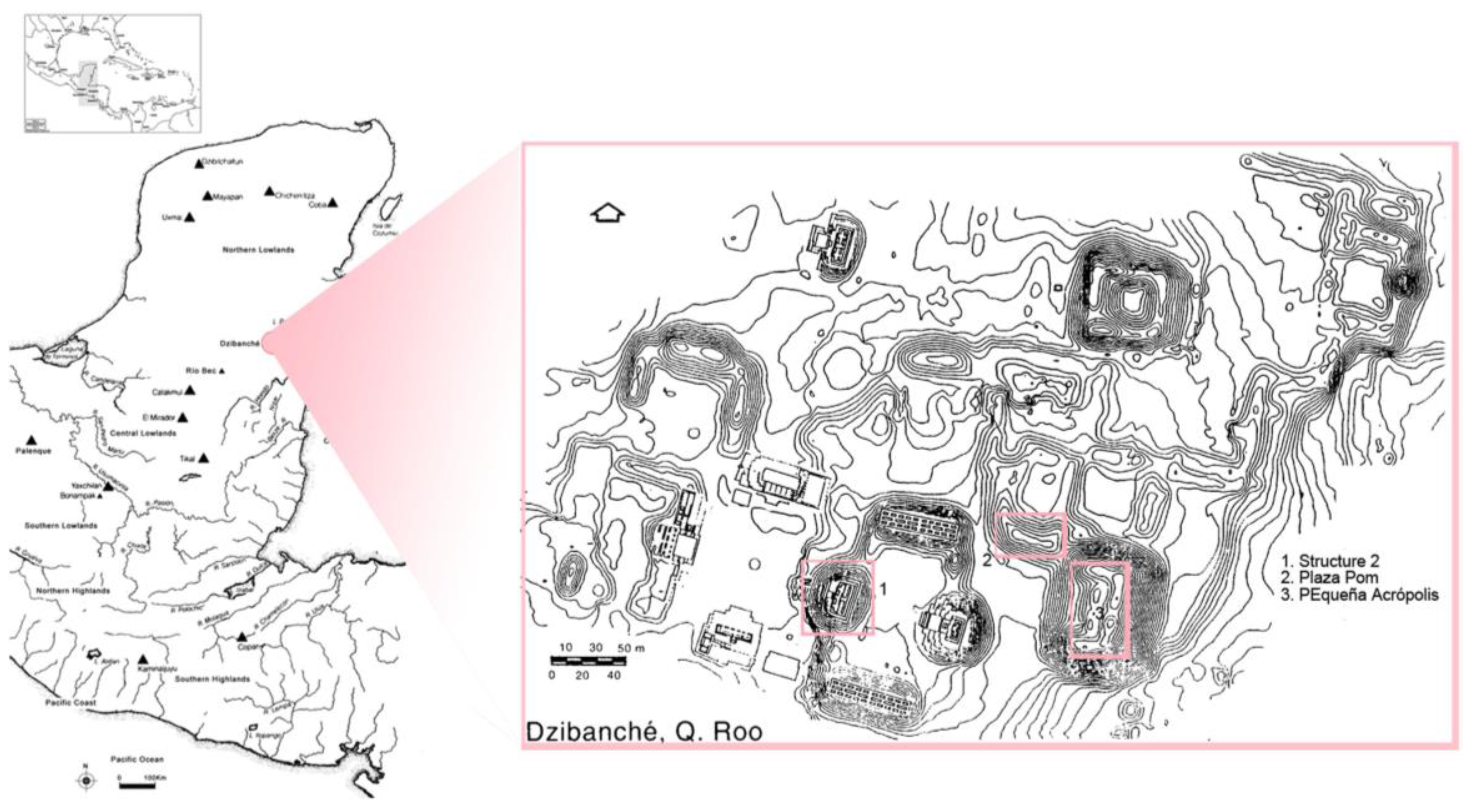
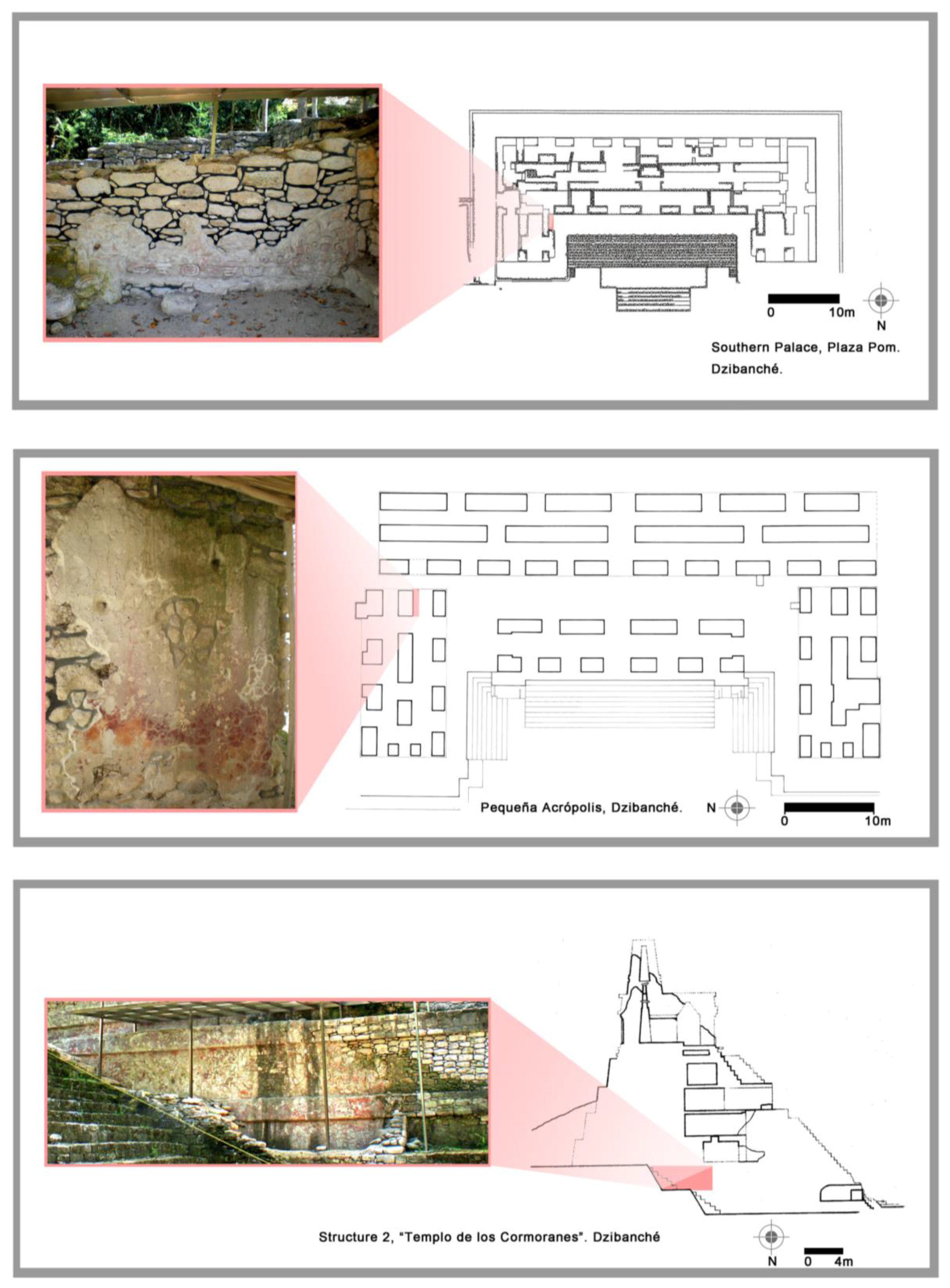
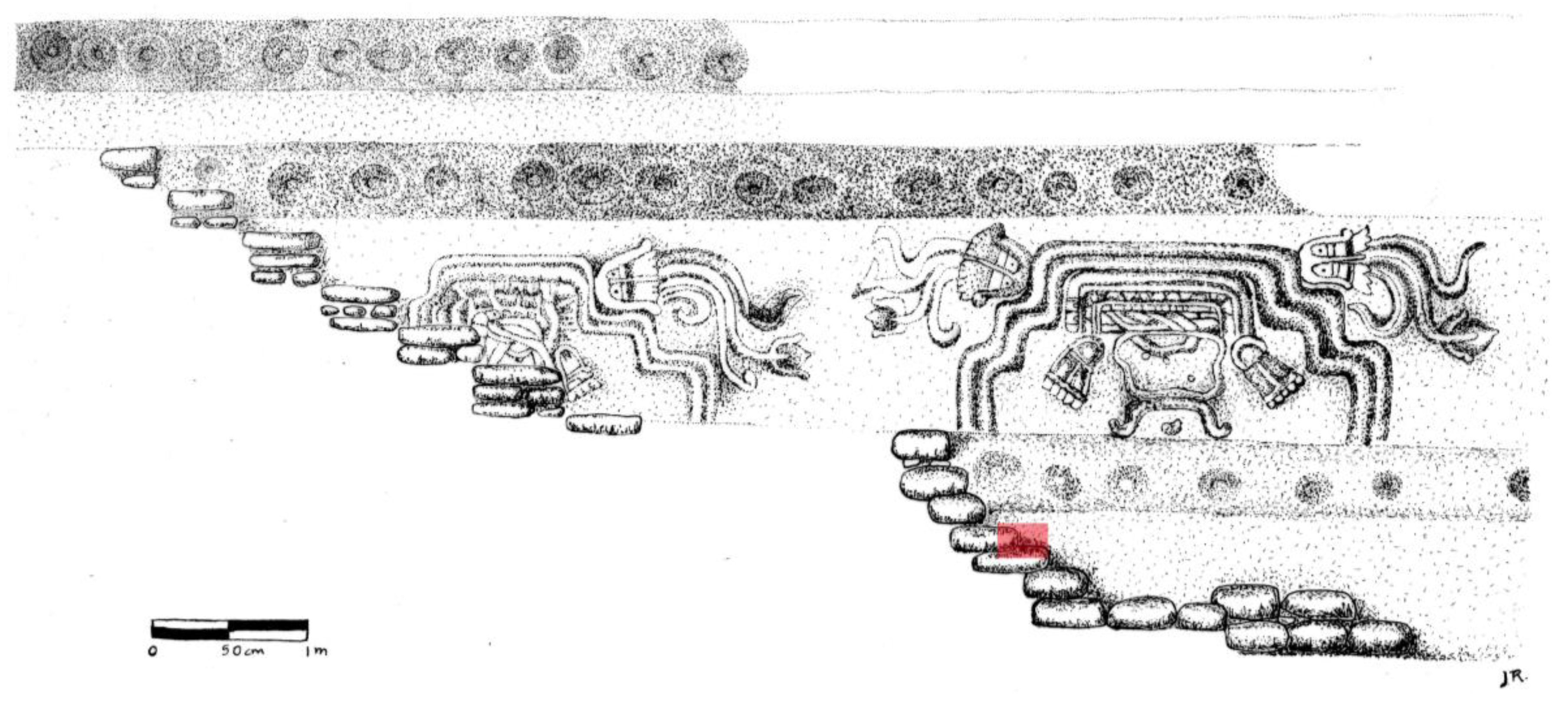
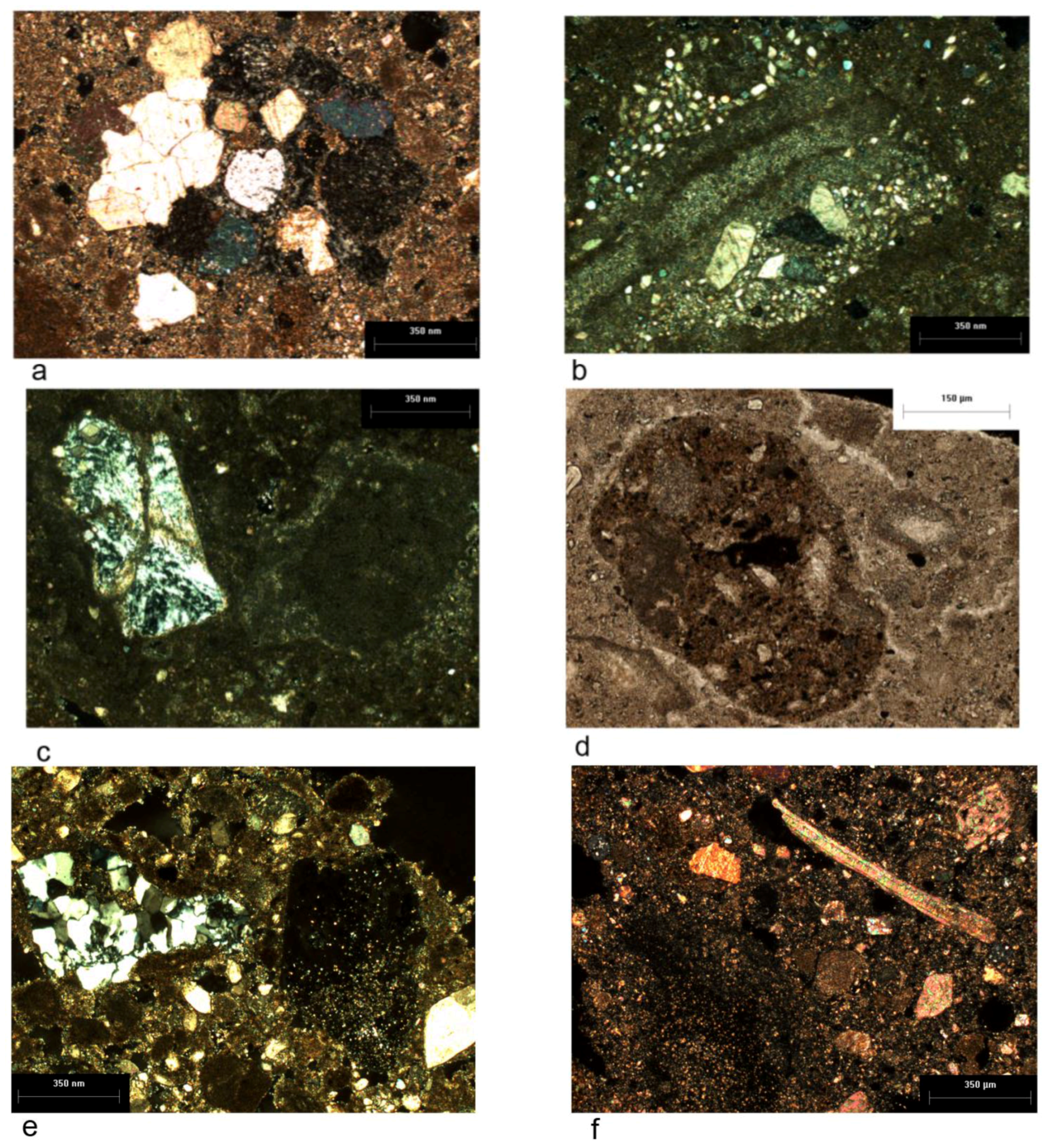

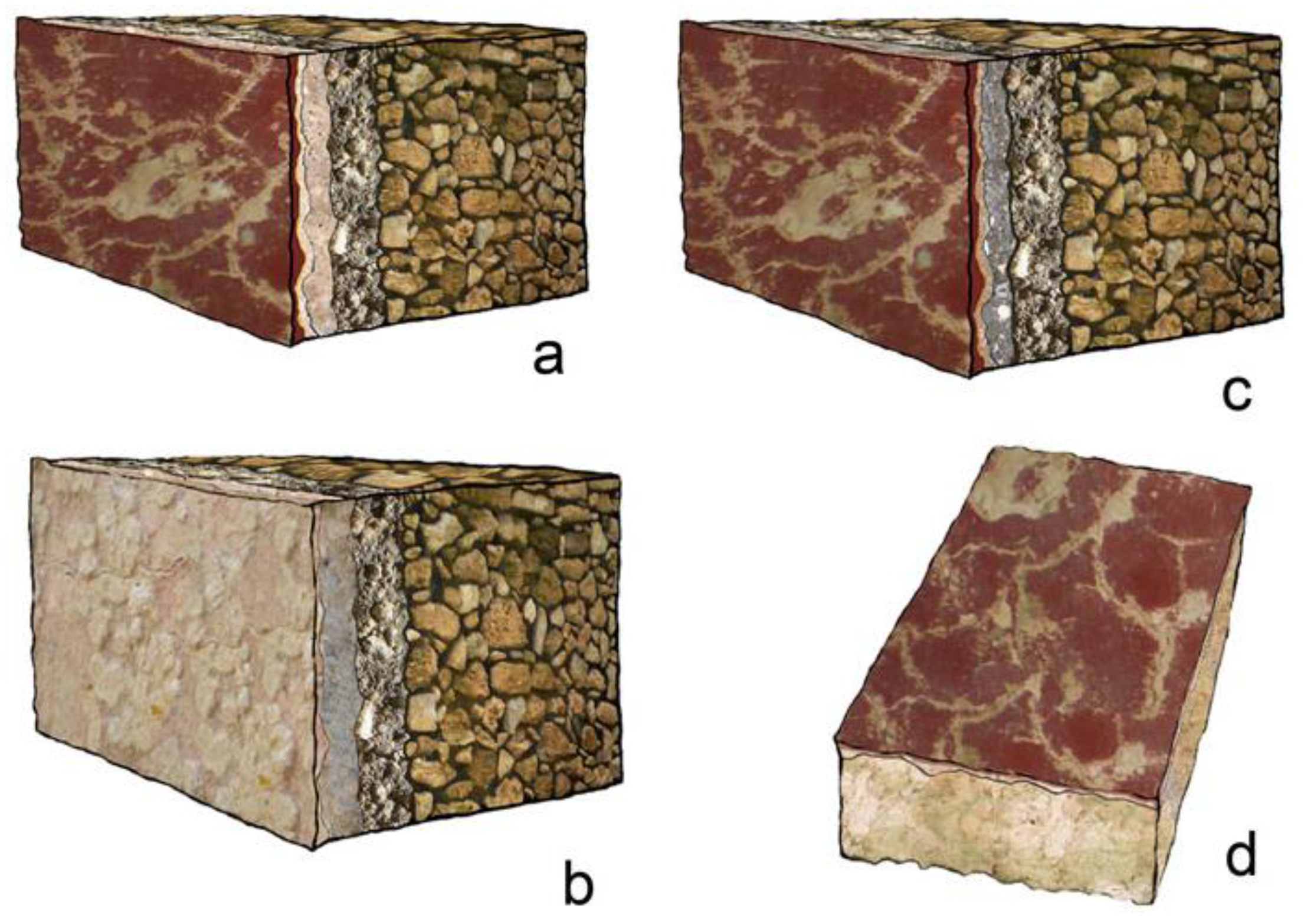
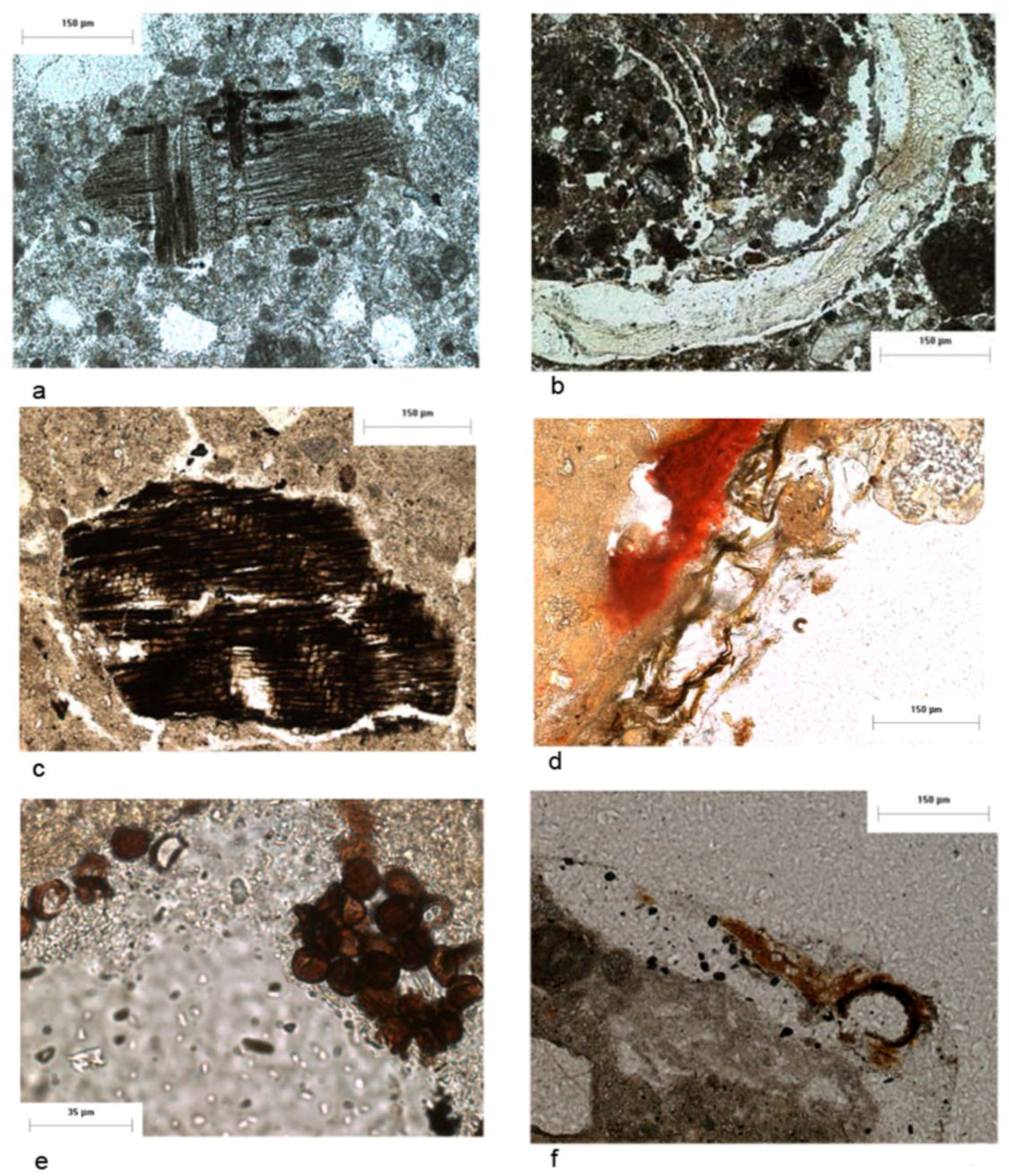
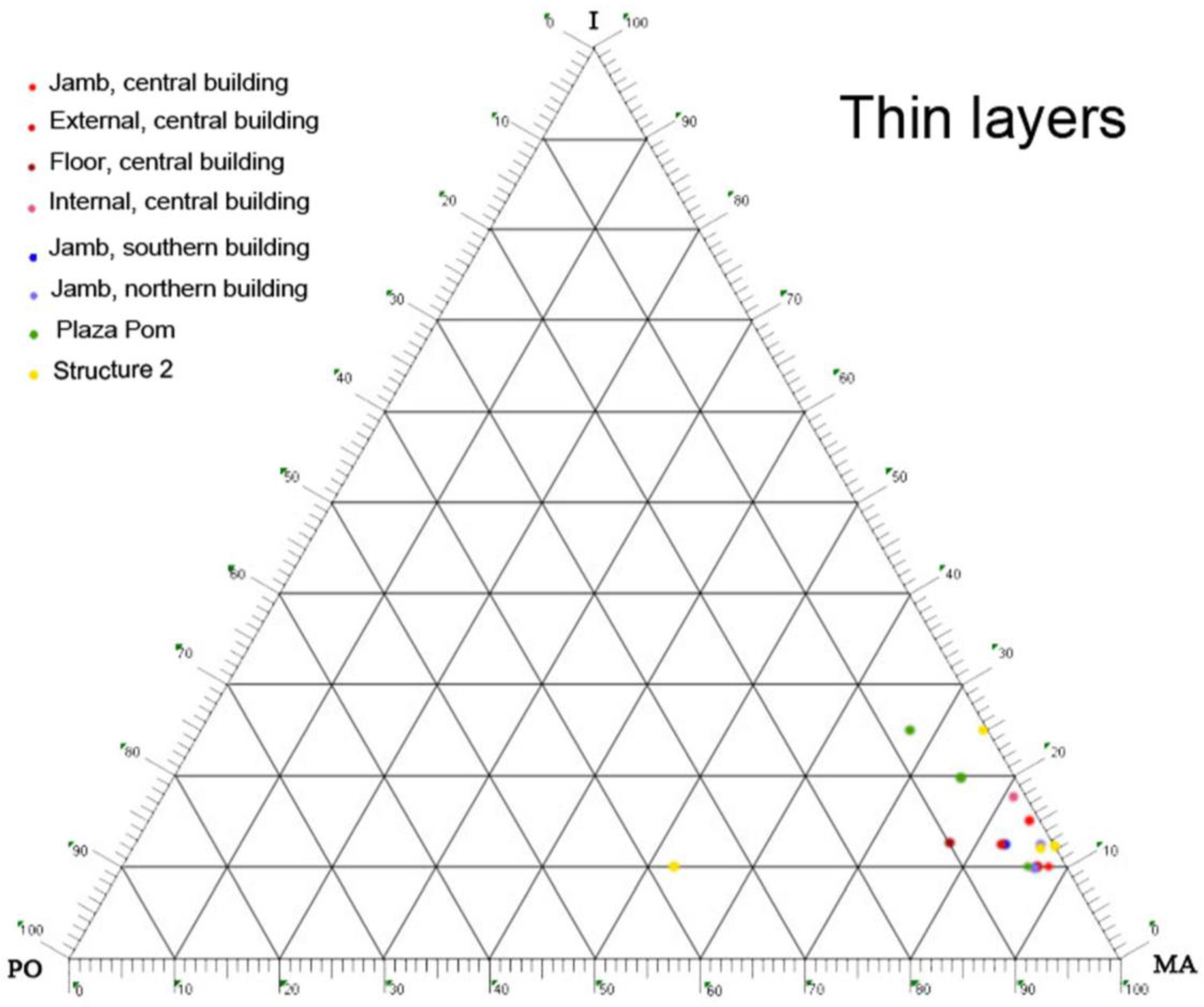
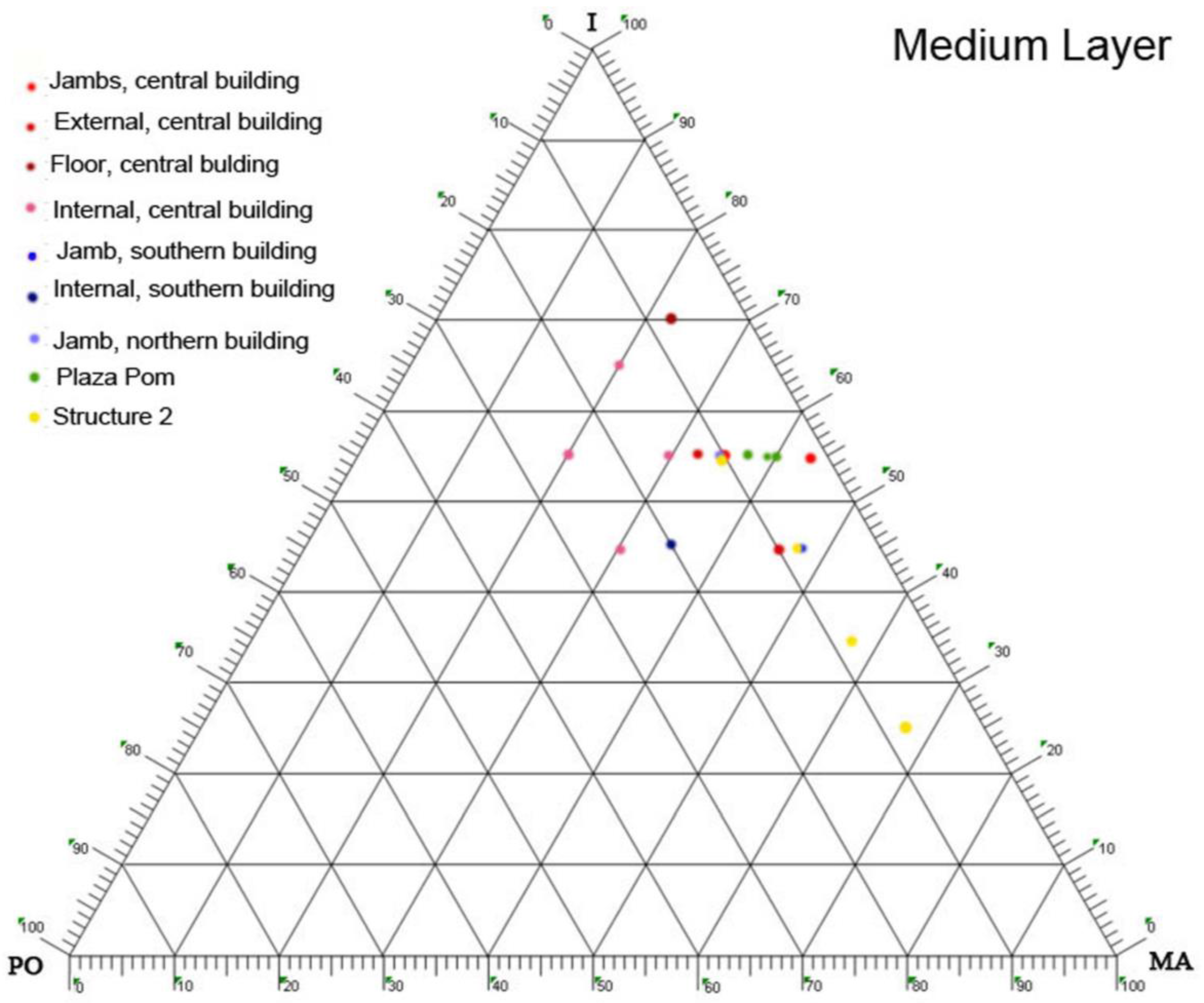
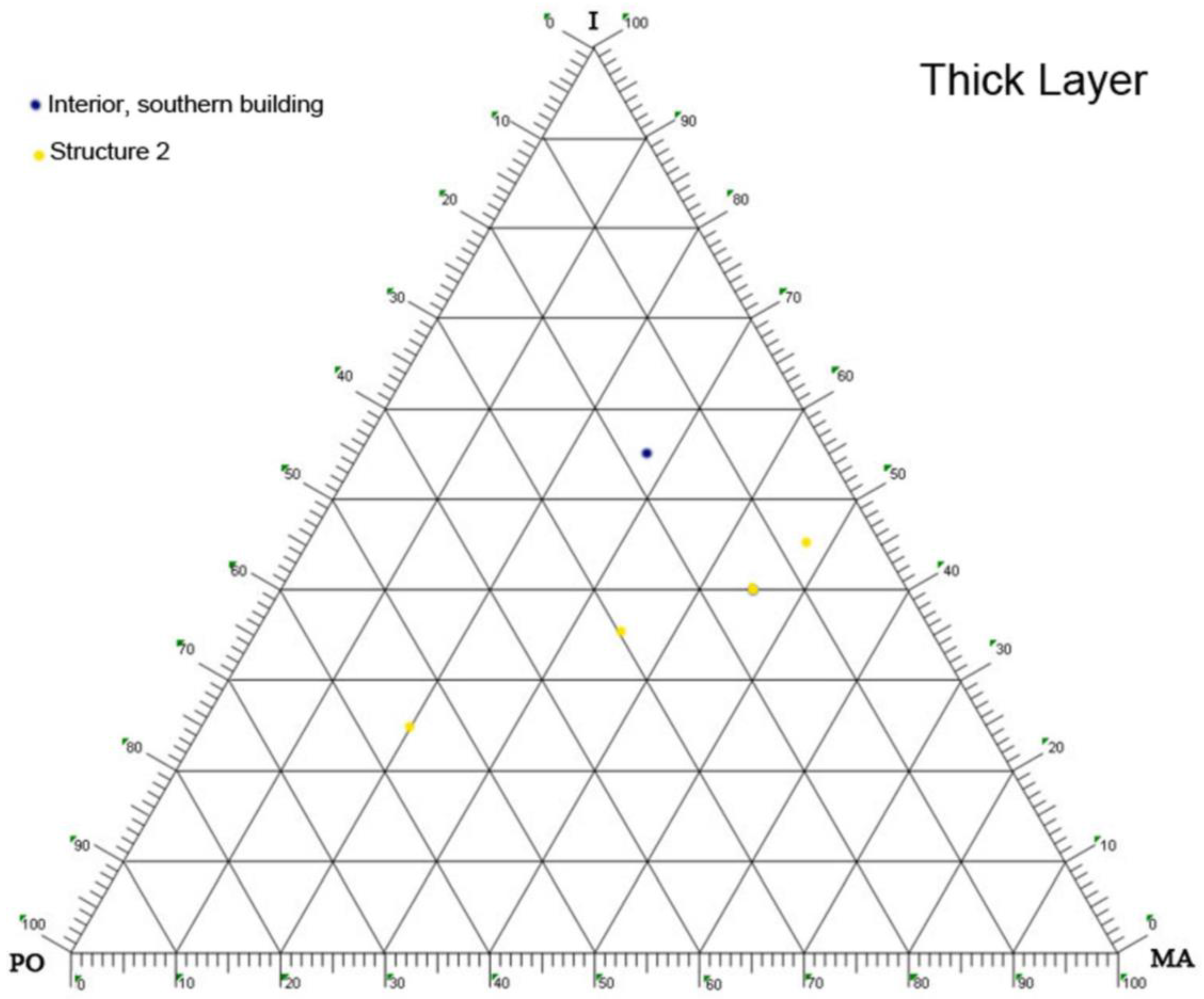
| Building | Particular Section of Each Building | Number of Specimens | Name |
|---|---|---|---|
| Pequeña Acrópolis | Southern building (sample 2 DZ2)) | 9 | 2A, 2B, 2C, 2D, 2E, 2F, 2G, 2H, 2I |
| Eastern building (sample 3 DZ3) | 10 | 3A, 3B, 3C, 3D, 3E, 3F, 3G, 3H, 3I, 3J | |
| Northern building (sample 4 DZ4) | 10 | 4A, 4B, 4C, 4D, 4E, 4F, 4G, 4H, 4I, 4J | |
| Structure 2 | Third body of the pyramidal structure (sample 1 DZ1) | 8 | 1A, 1B, 1C, 1D, 1E, 1F, 1G, 1H |
| Building | No. Sample | Sample Place | Description |
|---|---|---|---|
| Structure 2 | 1 | Stucco previously detached from the wall, came from the second body of the pyramidal structure on the right side | Fragment with a red pictorial layer that exhibits a particular deterioration in the form of a “net”, the stucco is powdered over the entire surface except in the areas next to fissures where the red layer prevails |
| 2 | Detached stucco, derived from the graffiti of green stones | Sample with blue paint remains. Grainy and deteriorated | |
| 3 | Section previously detached from the right side of the relief | Deteriorated stucco with a high level of loss on the surface, very powdery | |
| 4 | Detached section of the area between the depicted mountains | Stucco sample with orange color | |
| 5 | Detached sample of the deteriorated area | Sample with red pigment layer, with an area of barely deteriorated stucco and a very deteriorated area | |
| Plaza Pom | 6 | Archaeologically identified as VI, 19, Layer IIIc, 11.dic. 2009 | Pictorial layer in blue and red |
| 7 | Archaeologically identified as ESFN-1, collapse, level 2, 2009 | Decoration with red pictorial layer | |
| 8 | Identified as VI-18 Layer IIIc | With blue and yellow pictorial layer over a red one | |
| Structure 2 | 9 | Section that was taken of the sacred mountain portion of the mural | Sample of thick gray layer, very powdery |
| 10 | Sample taken in situ from the right, deteriorated area of the relief | Presents pictorial layer and efflorescences in the surface, relatively well conserved but in the section of a water flow | |
| Pequeña Acrópolis | 11 | 10 south | Fragments of a jamb detached and recollected from the ground. It seems that the detachment was due to a water flow. Humid, with red pictorial layer |
| 12 | 14 north | Fragment of a jamb with salts detached from the wall. Dry | |
| 13 | 14 north | Fragment of the same jamb but in a humid area. | |
| 14 | 29 west | Internal wall. Surface dissolved by water, humid, with a thin pinkish lime layer on the surface | |
| 15 | 29 west | Internal wall. Surface dissolved and eroded by the rain | |
| 16 | 31 east | Superior red plaster on the external façade, very thin over another plaster | |
| 17 | 31 east | Red inferior layer in the external façade. | |
| 18 | 31 west | Interior walls under a vault, eroded and dry lime plaster | |
| 19 | 31 west | Interior walls, no vault, with microorganisms, humid and eroded | |
| 20 | 36 north | Under a water flow, microorganisms, very humid | |
| 21 | Floor | Between the entry of wall 16 and 17 | |
| 22 | 36 north | Dry, with efflorescences | |
| 23 | 9 south | Wet, eroded | |
| 24 | 22 south | Lime plaster in jamb, pictorial layer conserved | |
| Structure 2 | 25 | MB1. Section detached near the left conserved half | Red pictorial layer, relatively well conserved |
| 26 | DBMB4. Section detached from the right half | Red and blue pictorial layer, relatively well conserved | |
| 27 | DNMB3. Section detached from the right half. | Very deteriorated, without pictorial layer. |
| Building | Sample | Thin Layer | Medium Layer | Coarse Layer | ||||||
|---|---|---|---|---|---|---|---|---|---|---|
| ma | in | po | ma | in | po | ma | in | po | ||
| Structure 2. | M1 | 85.5% | 10.5% | 4% | 67.5% | 25% | 7.5% | 45% | 40% | 15% |
| M2 | 35% | 55% | 10% | * | * | |||||
| M3 | * | * | 47.5% | 45% | 7.5% | |||||
| M4 | 74% | 25% | 1% | 47.5% | 42% | 10.5% | * | |||
| M5 | * | * | 37.5% | 37.5% | 25% | |||||
| M9 | * | * | 20% | 25% | 55% | |||||
| M10 | 86% | 12.5% | 1.5% | 55% | 35% | 10% | * | |||
| Plaza Pom. | M6 | 67.5% | 25% | 7.5% | 40% | 55% | 5% | * | ||
| M7 | 87% | 10% | 3% | 40% | 55% | 5% | * | |||
| M8 | 75% | 20% | 5% | 37.5% | 55% | 7.5% | * | |||
| External last plaster layer, Pequeña Acrópolis. | M16 | 82.5% | 12.5% | 5% | 45% | 45% | 10% | * | ||
| Layer | Building | mi | hi | si | c | cb | ch | sh | vt | s | Granulometry |
|---|---|---|---|---|---|---|---|---|---|---|---|
| Thin Layer | Structure 2 | 2.5 | 1 | 2.5 | 1 | 1 | - | - | - | - | Coarse sand to silt with fine and very fine sand |
| Plaza Pom | 3 | 1 | 3 | 1 | - | - | - | - | - | Medium sand to silt with fine sand | |
| External last plaster layer, Pequeña Acrópolis | 3 | 1 | 2 | - | - | - | - | - | - | Medium sand to silt with fine sand and silt. | |
| Medium Layer | Structure 2 | 4 | 3 | 3 | 1.5 | 1 | 1 | 1 | 1 | 2.5 | Fine gravel to silt with medium and fine sand |
| Plaza Pom | 4 | 3 | 4 | 3 | 2 | 1.5 | 1 | 1 | 1 | Fine gravel to silt with very coarse to fine sand. | |
| External last plaster layer, Pequeña Acrópolis | 4 | 3 | 3 | 2 | 1 | - | 1 | - | 2 | Fine gravel to silt with coarse to fine sand | |
| Coarse Layer | Structure 2 | 4 | 3.5 | 3 | 2.5 | 3 | 1.5 | 1 | 1 | 1.5 | Gravel to silt with very coarse and medium sand |
| Plaza Pom | * | ||||||||||
| External last plaster layer, Pequeña Acrópolis | * |
| Building | Sample | Thin Layer | Medium Layer | Coarse Layer | |||||||
|---|---|---|---|---|---|---|---|---|---|---|---|
| ma | in | po | pi | ma | po | pi | ma | po | Pi | ||
| Internal Walls of Eastern Building of Pequeña Acrópolis. | M14 | 80% | 17% | 2% | 1% | 20% | 55% | 25% | * | ||
| M15 | * | 20% | 65% | 15% | * | ||||||
| M18 | * | 30% | 45% | 25% | * | ||||||
| M19 | * | 29.5% | 55.5% | 15% | * | ||||||
| Internal Walls of Southern Building in Pequeña Acrópolis. | M23 | * | 35% | 45% | 20% | 27.5% | 55% | 17.5% | |||
| Layer | Building | mi | hi | si | c | cb | ch | sh | vt | s | Granulometry |
|---|---|---|---|---|---|---|---|---|---|---|---|
| Thin Layer | Internal Walls of Eastern Building of Pequeña Acrópolis. | 2 | - | 5 | - | - | - | - | - | - | Medium sand to silt |
| Internal Walls of Southern Building in Pequeña Acrópolis. | * | * | |||||||||
| Medium Layer | Internal Walls of Eastern Building of Pequeña Acrópolis. | 3 | 2 | 5 | 3 | 1 | 1 | - | 1 | 1 | Gravel to silt with fine to coarse sand |
| Internal Walls of Southern Building in Pequeña Acrópolis. | 3 | 2 | 4 | 3 | 1 | - | - | - | - | Fine gravel to silt with sand | |
| Coarse Layer | Internal Walls of Eastern Building of Pequeña Acrópolis. | * | * | ||||||||
| Internal Walls of Southern Building in Pequeña Acrópolis. | 3 | 4 | 4 | 3 | 4 | - | 2 | - | 3 | Gravel to silt with medium sand |
| Building (Pequeña Acrópolis) | Sample | Thin layer | Medium Layer | Coarse Layer | ||||
|---|---|---|---|---|---|---|---|---|
| ma | in | po | ma | in | po | |||
| Jambs of Eastern Building | M12 | 84% 15% 1% | 42.5% 54.5% 3% | * | ||||
| M13 | 88% 10% 2% | 35% 55% 10% | * | |||||
| Jambs of Northern Building | M20 | 86.5% 11.5% 2% | 35% 55% 10% | * | ||||
| M22 | 88% 10% 2% | 40% 45% 15% | * | |||||
| Jambs of Southern Building | M11 | 82.5% 12.5% 5% | 47.5% 45% 7.5% | * | ||||
| External First Plaster Layer | M17 | 87% 10% 3% | 32.5% 55% 12.5% | * | ||||
| Layer | Building (Pequeña Acrópolis) | mi | hi | ei | c | cb | ch | sh | vt | s | Granulometry |
|---|---|---|---|---|---|---|---|---|---|---|---|
| Thin Layer | Jambs of Eastern Building | 2.5 | 1 | 3 | 1 | 1 | - | - | - | - | Medium sand to silt |
| Jambs of Northern Building | 3 | - | 2 | 1 | 1.5 | - | - | 1 | 1 | Medium sand to silt with fine and very fine sand | |
| Jambs of Southern Building | 3 | - | 2 | 1 | - | - | - | - | 1 | Fine gravel to silt with fine sand | |
| External First Plaster Layer | 2 | 1 | 2 | - | - | - | - | - | - | Medium sand to silt with fine sand | |
| Medium Layer | Jambs of Eastern Building | 4 | 4 | 4 | 2 | 3 | 1 | 2 | 1 | 3 | Fine gravel to very fine sand with coarse to fine sand |
| Jambs of Northern Building | 4 | 3 | 4 | 3 | 4 | - | 1 | 1 | 3 | Fine gravel to silt with very coarse to fine sand | |
| Jambs of Southern Building | 4 | 5 | 4 | 3 | 4 | 1 | 1 | 1 | 3 | Fine gravel to silt with very coarse to very fine sand | |
| External First Plaster Layer | 4 | 4 | 4 | 3 | 4 | 1 | 3 | 1 | 3 | Fine gravel to silt with coarse to fine sand | |
| Coarse Layer | Jambs of Eastern Building | * | |||||||||
| Jambs of Northern Building | * | ||||||||||
| Jambs of Southern Building | * | ||||||||||
| External First Plaster Layer | * |
| Building (Pequeña Acrópolis) | Sample | Thin Layer | Medium Layer | Coarse Layer | ||||
|---|---|---|---|---|---|---|---|---|
| ma | In | po | ma | in | po | |||
| Floor | M21 | 77.5% | 12.5% | 10% | 32.5% | 55% | 12.5% | * |
| Layer | Building (Pequeña Acrópolis) | Mi | hi | Ei | c | cb | ch | sh | vt | S | Granulometry |
|---|---|---|---|---|---|---|---|---|---|---|---|
| Thin layer | Floor | 2 | - | 2 | - | - | - | - | - | - | Fine sand to silt |
| Medium layer | Floor | 4 | 4 | 4 | 2 | 1 | - | - | - | - | Fine gravel to silt |
| Building | Sub-Area | Vegetal Tissue | Cyanobacteria | Possible Sporangium | Possible Lichen | |||
|---|---|---|---|---|---|---|---|---|
| Structure 2 | Right section | M9-coarse layer | - | - | M5-coarse layer | Humid | M9-coarse layer | Humid |
| M10-medium layer | M10-medium layer | |||||||
| Plaza Pom | Detached fragments | M6-medium layer | - | - | M8-Pictorial layer | Dry | M8-medium layer | Dry |
| M8-Medium layer | ||||||||
| Pequeña Acrópolis | Southern building | M11-medium layer | - | - | M23-medium layer | Humid | M11- medium layer | Humid |
| External faҫade Eastern building | M17-medium layer | M16-thin layer | Humid | - | - | - | - | |
| M16-medium layer | ||||||||
| Internal walls Eastern building | M15-medium layer | M19-deposit layer | Humid | M15-medium layer | Humid | - | - | |
| M19-medium layer | M19-deposit layer | |||||||
| Jambs Eastern building | M12-medium layer | M13-deposit layer | Humid | M13-deposit layer | Humid | M12-medium layer | Dry | |
| M13-medium layer | ||||||||
| Floor Eastern building | - | M21-thin layer | Humid | M21-thin layer | Humid | - | - | |
| M21-medium layer | M21-medium layer | |||||||
| Northern building | M22-thin layer | M20-deposit layer | Humid | M20-deposit layer | Humid dry | M20-medium layer | Humid | |
| M22-coarse layer | M20- medium layer | M22-medium layer | ||||||
| Building | Subarea | Weathered | Rhamnose% | Galactose% | Manose% | Glucose% | Xylose% | Inositol% | Fucose% | Non Identify% |
|---|---|---|---|---|---|---|---|---|---|---|
| Pequeña Acrópolis | Jambs | Yes | - | - | - | 100 | - | - | - | - |
| No | 15 | 12.4 | 7.5 | 64.9 | - | - | - | - | ||
| Internal walls | Yes | - | - | - | 100 | - | - | - | - | |
| No | 3.35 | 8.47 | 8.96 | 77.31 | 1.90 | Not quantified | - | - | ||
| Floor | Yes | - | - | - | 100 | - | - | - | - | |
| Structure 2 | Right section | Yes | - | - | - | 100 | - | - | - | - |
| Left section | No | 33.3 | 60.5 | - | - | - | - | 1.7 | 4.5 | |
| Left section | No | 9.03 | 9.30 | 10.16 | 56.11 | 15.39 | - | - | - | |
| Plaza Pom | Detached fragments | No | - | 10.99 | 11.52 | 71.18 | 6.31 | - | - | - |
| Sample | Dating | Graphics |
|---|---|---|
| DZ1-Structure 2 DecM-313.3 IncM-38.5 α95-13.3 r-3.895 k-28.57 | 191–222 274–316 851–873 1163–1177 |  |
| DZ2-Pequeña Acrópolis, southern building DecM-23.5 IncM-24 α95-16.5 r = 3.841 k = 18.85 | 0–141 366–430 500–531 551–599 681–748 802–817 837–845 1130–1145 1192–1199 |  |
| DZ3. Pequeña Acrópolis, eastern building DecM-359.4 IncM-55.6 α95-15.4 r = 4.760 k = 16.66 | 86–162 325–329 422–521 565–605 716–739 1070–1094 |  |
| DZ4. Pequeña Acrópoli, northern building DecM-49.5 IncM-65.0 α95-9.4 r = 5.800 k = 24.96 | 463–508 833–841 |  |
| Building | Section | Thin Layer | Medium Layer | Coarse Layer | Dates | |||||||
|---|---|---|---|---|---|---|---|---|---|---|---|---|
| ma | in | po | Pi | ma | In | po | ma | in | po | |||
| Eastern building, Pequeña Acrópolis | Jambs | 1 | 0.14 | 0.02 | - | 1 | 1.41 | 0.17 | - | - | - | AD 422–521 |
| External superior | 1 | 0.15 | 0.06 | - | 1 | 1.00 | 0.22 | - | - | - | Suggested AD 500–521 | |
| External inferior | 1 | 0.11 | 0.03 | - | 1 | 1.69 | 0.38 | - | - | - | Suggested AD 422–521 | |
| Floor | 1 | 0.16 | 0.12 | - | 1 | 3.10 | 0.33 | - | - | - | Suggested AD 422–521 | |
| Internal walls | 1 | 0.21 | 0.02 | 0.01 | 1 | 3.00 | 1 | - | - | - | Suggested AD 422–521 | |
| Northern building, Pequeña Acrópolis | Jambs | 1 | 0.12 | 0.02 | - | 1 | 1.34 | 0.32 | - | - | - | AD 563–508 |
| Southern building, Pequeña Acrópolis | Jambs | 1 | 0.15 | 0.06 | - | 1 | 0.94 | 0.15 | - | - | - | AD 500–531 |
| Internal walls | - | - | - | - | 1 | 1.20 | 0.5 | 1 | 2 | 0.63 | Suggested AD 500–531 | |
| Plaza Pom | - | 1 | 0.24 | 0.06 | - | 1 | 1.40 | 0.14 | - | - | - | Suggested AD 422–521 |
| Structure 2 | - | 1 | 0.20 | 0.20 | - | 1 | 0.63 | 0.31 | 1 | 0.94 | 0.37 | AD 274–316 |
© 2016 by the authors; licensee MDPI, Basel, Switzerland. This article is an open access article distributed under the terms and conditions of the Creative Commons Attribution (CC-BY) license (http://creativecommons.org/licenses/by/4.0/).
Share and Cite
Straulino Mainou, L.; Sedov, S.; Soler Arechalde, A.M.; Pi Puig, T.; Villa, G.; Balanzario Granados, S.; Doménech-Carbó, M.-T.; Osete-Cortina, L.; Leonard, D. Maya Lime Mortars—Relationship between Archaeomagnetic Dating, Manufacturing Technique, and Architectural Function—The Dzibanché Case. Geosciences 2016, 6, 49. https://doi.org/10.3390/geosciences6040049
Straulino Mainou L, Sedov S, Soler Arechalde AM, Pi Puig T, Villa G, Balanzario Granados S, Doménech-Carbó M-T, Osete-Cortina L, Leonard D. Maya Lime Mortars—Relationship between Archaeomagnetic Dating, Manufacturing Technique, and Architectural Function—The Dzibanché Case. Geosciences. 2016; 6(4):49. https://doi.org/10.3390/geosciences6040049
Chicago/Turabian StyleStraulino Mainou, Luisa, Sergey Sedov, Ana María Soler Arechalde, Teresa Pi Puig, Gerardo Villa, Sandra Balanzario Granados, María-Teresa Doménech-Carbó, Laura Osete-Cortina, and Daniel Leonard. 2016. "Maya Lime Mortars—Relationship between Archaeomagnetic Dating, Manufacturing Technique, and Architectural Function—The Dzibanché Case" Geosciences 6, no. 4: 49. https://doi.org/10.3390/geosciences6040049





